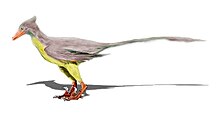Rahonavis
| Rahonavis Temporal range: Upper Cretaceous, 70 million years ago
| |
|---|---|

| |
| Scientific classification | |
| Kingdom: | |
| Class: | |
| Superorder: | |
| Order: | |
| Suborder: | |
| Family: | |
| Genus: | Rahonavis
|
Rahonavis is a genus of bird-like feathered dinosaur from the Upper Cretaceous, 70–65 million years ago (mya) of what is now northwestern Madagascar.
It is known from a partial skeleton found in a quarry. Rahonavis was a small predator, at about 70 centimetres (2.3 ft) long,[1] with the typical Velociraptor-like raised sickle claw on the second toe.
Classification
[change | change source]Rahonavis has quill knobs on its ulna (forearm bone), which led at first to its inclusion among the birds. However, the rest of the skeleton is rather typically dromaeosaurid.
Makovicky and colleagues consider Rahonavis to be closely related to the South American dromaeosaurids Unenlagia and Buitreraptor, and thus a member of the subfamily Unenlagiinae.[2] Norell and colleagues (2006) also found Rahonavis to lie within the Unenlagiinae, as the sister taxon to Unenlagia itself.[3] A 2007 study by Turner and colleagues again found it to be closely related to Unenlagia.[4] However, studies published since 2009 that have found many traditional "dromaeosaurids", including the unenlagiines, closer to Avialae than to dromaeosaurines. A cladistic analysis recovered Rahonavis as a probable relative of Jeholornis and Jixiangornis.[5][6]
Paleobiology
[change | change source]
Rahonavis was one-fifth larger than the closely related Archaeopteryx, about the size of a modern raven.[7]
Although numerous artists' reconstructions of Rahonavis show it in flight, it is not clear that it could fly. There is even been some doubt that the forearm material, which includes the quill knobs, belongs with the rest of the skeleton. Some researchers have suggested that Rahonavis represents a chimaera, with the forelimb of a bird mixed with the skeleton of a dromaeosaurid.[8]
The nearby discovery of the primitive bird Vorona berivotrensis shows that the possibility of a mix-up cannot be entirely excluded. However, many other scientists, including the original describers of Rahonavis, think its remains belong to a single animal. The wing bones are close to the rest of the skeleton. All the bones attributed to Rahonavis were buried in an area "smaller than a letter-sized page", according to co-describer Luis M. Chiappe in his 2007 book Glorified Dinosaurs.[7] Chiappe maintained that Rahonavis could probably fly, noting that its ulna was large and robust compared to Archaeopteryx, and that this fact, coupled with the prominent quill knobs, suggest that Rahonavis had larger and more powerful wings than that earlier bird. In addition, Rahonavis shoulder bones show evidence of ligament attachments allowing the independent mobility needed for flapping flight. Chiappe concluded that Rahonavis was capable of flight, though it would have been more "clumsy in the air than modern birds".[7]
References
[change | change source]- ↑ Holtz, Thomas R. Jr. 2008. Dinosaurs: the most complete, up-to-date encyclopedia for dinosaur lovers of all ages. Supplementary Information
- ↑ Makovicky, Peter J.; Apesteguía, Sebastián; Agnolín, Federico L. (2005). "The earliest dromaeosaurid theropod from South America". Nature. 437 (7061): 1007–1011. Bibcode:2005Natur.437.1007M. doi:10.1038/nature03996. PMID 16222297. S2CID 27078534. Supplementary information.
- ↑ Norell, M.A.; et al. (2006). "A new dromaeosaurid theropod from Ukhaa Tolgod (Omnogov, Mongolia)". American Museum Novitates (3545): 1–51. doi:10.1206/0003-0082(2006)3545[1:ANDTFU]2.0.CO;2.
- ↑ Turner, Alan H.; et al. (2007). "A basal dromaeosaurid and size evolution preceding avian flight" (PDF). Science. 317 (5843): 1378–1381. Bibcode:2007Sci...317.1378T. doi:10.1126/science.1144066. PMID 17823350. S2CID 2519726.
- ↑ Agnolín, F.L.; Novas, F.E. (2013). "Avian ancestors. A review of the phylogenetic relationships of the theropods Unenlagiidae, Microraptoria, Anchiornis and Scansoriopterygidae". SpringerBriefs in Earth System Sciences. pp. 1–96.
- ↑ Andrea Cau (2018). "The assembly of the avian body plan: a 160-million-year long process" (PDF). Bollettino della Società Paleontologica Italiana. 57 (1): 1–25. doi:10.4435/BSPI.2018.01.
- ↑ 7.0 7.1 7.2 Chiappe, L.M. (2 February 2007). Glorified Dinosaurs: the origin and early evolution of birds. Sydney: UNSW Press. ISBN 9780471247234.
- ↑ Geist, Nicholas R.; Feduccia, Alan (2000). "Gravity-defying behaviors: identifying models for Protoaves" (PDF). American Zoologist. 40 (4): 664–675. doi:10.1668/0003-1569(2000)040[0664:GDBIMF]2.0.CO;2. S2CID 11576813.
Further reading
[change | change source]- Forster, Catherine A.; O'Conner (2000). "The avifauna of the Upper Cretaceous Maevarano Formation, Madagascar". Journal of Vertebrate Paleontology. 3 (20): 41A–42A.
- Schweitzer, Mary H.; et al. (1999). "Keratin immunoreactivity in the late Cretaceous bird Rahonavis ostromi". Journal of Vertebrate Paleontology. 4 (19): 712–722. doi:10.1080/02724634.1999.10011183. JSTOR 4524040.
